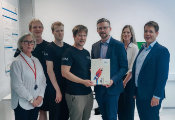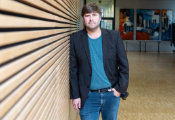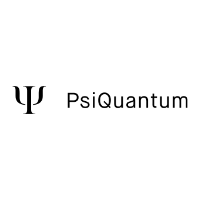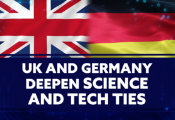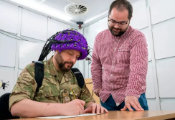Rice Researchers Lead Project Using Quantum Phenomenon to Transform Super-Resolution Imaging
January 27, 2025 -- A multidisciplinary team of researchers from Rice University and Texas A&M University has received a $1.2 million award from the W.M. Keck Foundation to advance super-resolution imaging and single-molecule tracking by harnessing super-radiance, a quantum optical phenomenon with transformative potential for research and innovation in medicine, engineering and the physical sciences.
Super-resolution imaging (SRI) and single-molecule tracking (SMT) allow scientists to observe molecular-scale processes with extraordinary detail. However, these techniques face inherent trade-offs: Achieving higher spatial resolution slows down the imaging process, while faster imaging sacrifices spatial resolution. Moreover, a fundamental limit constrains how precisely individual molecules can be localized.
The newly funded project seeks to break these barriers using super-radiance — a phenomenon that occurs when quantum systems such as molecules or nanomaterials collectively emit light in a coordinated and enhanced manner, resulting in greater brightness and faster emission rates. Although this phenomenon has been extensively studied in atomic systems, its application in solid-state and molecular systems remains rare.
“Super-radiance offers a fundamentally new way to rethink imaging at the molecular level,” said Shengxi Huang, associate professor of electrical and computer engineering and bioengineering at Rice and the research team’s principal investigator. “We aim to translate this quantum property into a powerful tool for imaging with potential applications in biology, chemistry, physics, engineering, etc.”
The research plan involves the development of fluorophores — light-emitting chemical compounds — that can achieve super-radiance. Unlike conventional fluorophores typically used for SRI and SMT that employ individual fluorescent molecules, the new fluorophore design will include aggregates of fluorescent molecules and bundles of carbon nanotubes.
“By making aggregates of such fluorophores and by achieving super-radiance, we will significantly enhance their brightness and emission rate,” Huang said. “Engineering super-radiant fluorophores for SRI and SMT could open up unknown worlds with even better spatial resolution and finer temporal resolution.”
The project is highly interdisciplinary, integrating cutting-edge quantum physics with advanced bioimaging techniques. By leveraging super-radiance, the researchers aim to address critical challenges in SRI and SMT, including high-throughput imaging and tracking of molecular processes. These improvements could catalyze breakthroughs across fields such as cell biology, materials science and nanotechnology.
“With this technology, we could observe cellular mechanisms in real time and with unmatched clarity,” said Huang. “This opens the door to discoveries we’ve only imagined.”
By observing and applying super-radiance in new ways, the researchers are not only enhancing imaging technologies but also deepening scientific understanding of quantum phenomena. This could translate into advancements in quantum technologies such as novel light sources, ultrafast optical switching, quantum energy harvesting and super-radiance-enhanced sensing.
The initiative’s goals are supported by a team of experts spanning multiple disciplines, including quantum physics, materials science, photonic engineering, chemistry and bioengineering.
“This project exemplifies the kind of collaboration that is essential for tackling the most complex scientific problems,” said Junichiro Kono, Rice’s Karl F. Hasselmann Professor in Engineering, professor of electrical and computer engineering, physics and astronomy and materials science and nanoengineering and faculty director of the Smalley-Curl Institute (SCI).
In addition to Huang and Kono, the research team includes Anna-Karin Gustavsson, assistant professor of chemistry at Rice; Yuji Zhao, professor of electrical and computer engineering at Rice; and Alexey Belyanin, associate department head and professor of physics and astronomy and the Ed Rachal Foundation Endowed Chair in Science at Texas A&M.
The team is based on a SCI Thematic Working Interest Group (TWIG) — a self-assembled collaboration of faculty from across multiple departments in Rice’s schools of natural sciences and engineering and computing. Awards to members of the TWIG amount to approximately $10 million, showcasing the success of TWIGs as a platform for collaboration. SCI began convening TWIGs in 2021 with over a dozen groups established to foster innovative research and pursue funding opportunities.
Based in Los Angeles, the W.M. Keck Foundation was established in 1954 by the late William Myron Keck, founder of the Superior Oil Company. The foundation’s grants are focused primarily on pioneering efforts in medical research and science and engineering. The foundation also supports undergraduate education and maintains a Southern California Grant Program that provides support for the Los Angeles community with a special emphasis on children and youth.









